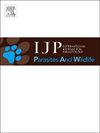Leishmania infantum and other zoonotic pathogens associated with captive lemurs (Lemur catta) in southern Italy
IF 2
3区 医学
Q3 ECOLOGY
International Journal for Parasitology-Parasites and Wildlife
Pub Date : 2025-05-29
DOI:10.1016/j.ijppaw.2025.101094
引用次数: 0
Abstract
Safari-style zoological collections, particularly walk-in enclosures, offer visitors the unique experience of a close interaction with wildlife. However, these interactions can increase the risk of exposure to zoonotic infectious agents. In this study, we assessed the occurrence of zoonotic pathogens in ring-tailed lemurs (Lemur catta), as well as the presence of Leishmania spp. in phlebotomine sand flies collected in the same zoological park (Fasano, southern Italy). Blood (n = 30), feces (n = 29), and sand flies were collected and analyzed using molecular and serological techniques. In addition, copro-parasitological analysis was performed on fecal samples. Two lemurs tested seropositive for L. infantum using SNAP® Leish 4Dx® (n = 2/30 [6.67 %; 95 % CI: 1.85–21.34]), with one also confirmed positive by qPCR. Sand flies were morphologically identified as Phlebotomus perniciosus (n = 71) and Sergentomyia minuta (n = 1), with one P. perniciosus female positive for L. infantum by qPCR. Fecal samples scored positive at molecular analysis for Giardia duodenalis (assemblage B, sub-assemblage BIV) (n = 13/29 [44.83 %; 95 % CI: 27.63–63.09]; n = 2/29 [6.90 %; 95 % CI: 1.91–22.57]), respectively), Blastocystis sp. (subtype 8) (n = 2/29 [6.90 %; 95 % CI: 1.91–22.57]), and Entamoeba coli (n = 8/29 [27.59 %; 95 % CI: 14.59–45.96]). The detection of L. infantum in lemurs and P. perniciosus suggests that in areas where L. infantum is endemic this animal species may be infected, also demonstrating that SNAP® Leish 4Dx® is effective for screening L. infantum in zoological settings. The identification of G. duodenalis (assemblage BIV), and Blastocystis sp. (ST8) raises concerns about contamination in enclosures, water, and food sources, overall highlighting the importance of sanitary protocols to avoid the risk of infection among animals, zookeepers and visitors.

意大利南部与圈养狐猴(狐猴)有关的幼利什曼原虫和其他人畜共患病原体
游猎式的动物收藏,尤其是步入式的围栏,为游客提供了与野生动物亲密互动的独特体验。然而,这些相互作用可增加暴露于人畜共患感染原的风险。在这项研究中,我们评估了环尾狐猴(Lemur catta)中人畜共患病原体的发生情况,以及在同一动物园(意大利南部Fasano)采集的白蛉中利什曼原虫的存在。采集血液(30例)、粪便(29例)和沙蝇,采用分子和血清学技术进行分析。此外,还对粪便样本进行了共寄生虫学分析。用SNAP®Leish 4Dx®检测2只狐猴婴儿乳杆菌血清阳性(n = 2/30 [6.67%;95% CI: 1.85 ~ 21.34]),其中1例qPCR阳性。经形态学鉴定为白蛉71只和细纹蛇蛉1只,其中1只母白蛉qPCR检测为婴儿乳杆菌阳性。粪便样本十二指肠贾第虫(组合B,亚组合BIV)分子分析阳性(n = 13/29 [44.83%;95% ci: 27.63-63.09];N = 2/29 [6.90%;95% CI: 1.91-22.57]), Blastocystis sp.(8亚型)(n = 2/29) [6.90%;95% CI: 1.91 ~ 22.57]),大肠内阿米巴(n = 8/29) [27.59%;95% ci: 14.59-45.96])。狐猴和perniciosus中婴儿乳杆菌的检测表明,在婴儿乳杆菌流行的地区,该动物物种可能被感染,也表明SNAP®Leish 4Dx®在动物环境中筛查婴儿乳杆菌是有效的。十二指肠G.(组合BIV)和囊虫sp. (ST8)的鉴定引起了人们对围栏、水和食物来源污染的关注,总体上强调了卫生规程的重要性,以避免动物、动物园管理员和游客之间的感染风险。
本文章由计算机程序翻译,如有差异,请以英文原文为准。
求助全文
约1分钟内获得全文
求助全文
来源期刊

International Journal for Parasitology-Parasites and Wildlife
Medicine-Infectious Diseases
CiteScore
3.80
自引率
5.60%
发文量
113
审稿时长
45 days
期刊介绍:
The International Journal for Parasitology: Parasites and Wildlife (IJP-PAW) publishes the results of original research on parasites of all wildlife, invertebrate and vertebrate. This includes free-ranging, wild populations, as well as captive wildlife, semi-domesticated species (e.g. reindeer) and farmed populations of recently domesticated or wild-captured species (e.g. cultured fishes). Articles on all aspects of wildlife parasitology are welcomed including taxonomy, biodiversity and distribution, ecology and epidemiology, population biology and host-parasite relationships. The impact of parasites on the health and conservation of wildlife is seen as an important area covered by the journal especially the potential role of environmental factors, for example climate. Also important to the journal is ''one health'' and the nature of interactions between wildlife, people and domestic animals, including disease emergence and zoonoses.
 求助内容:
求助内容: 应助结果提醒方式:
应助结果提醒方式:


